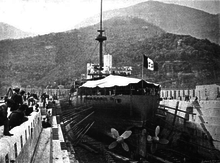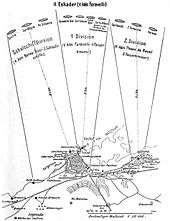Italian ironclad Re Umberto
 Re Umberto at Brindisi in 1917 | |
| History | |
|---|---|
| Name: | Re Umberto |
| Namesake: | Umberto I of Italy |
| Builder: | Castellammare Naval Shipyard |
| Laid down: | 10 July 1884 |
| Launched: | 17 October 1888 |
| Completed: | 16 February 1893 |
| Struck: | 10 May 1914 |
| Reinstated: | 9 December 1915 |
| Fate: | Stricken 1920 |
| General characteristics Re Umberto | |
| Class and type: | Re Umberto-class ironclad battleship |
| Displacement: |
|
| Length: | 418 ft 7.5 in (127.6 m) |
| Beam: | 76 ft 10.5 in (23.4 m) |
| Draft: | 30 ft 6 in (9.3 m) |
| Installed power: |
|
| Propulsion: | 2 shafts, compound steam engines |
| Speed: | 18.5 knots (34.3 km/h; 21.3 mph) |
| Range: | 4,000–6,000 nmi (7,400–11,100 km; 4,600–6,900 mi) at 10 knots (19 km/h; 12 mph) |
| Complement: | 733 |
| Armament: |
|
| Armor: |
|
Re Umberto ("King Humbert") was a Re Umberto-class ironclad battleship built for the Italian Regia Marina (Royal Navy) in the 1880s, the lead ship of her class. She was laid down in July 1884 and launched in October 1888; work proceeded so slowly that she was not finished until February 1893. She was armed with a main battery of four 13.5-inch (340 mm) guns and had a top speed of 20.3 knots (37.6 km/h; 23.4 mph), though this high speed came at the cost of armor protection.
Re Umberto carried out various duties during her service career, including large-scale fleet maneuvers and diplomatic missions in Europe. She saw limited action during the Italo-Turkish War in 1911–12, escorting convoys and bombarding Ottoman troops in North Africa. By the end of the year she was withdrawn from front-line service. Decommissioned before World War I, she was used during the war as a depot ship and then as a floating battery. In 1918 her armament was exchanged for a number of 3-inch (76 mm) guns and trench mortars as part of her role as the lead ship in the planned Italian assault on the main Austro-Hungarian naval base at Pola. The war ended before the Italians could carry out the attack and she was stricken again in 1920.
Design

Re Umberto was 127.6 meters (419 ft) long overall; she had a beam of 23.44 m (76.9 ft) and an average draft of 9.29 m (30.5 ft). She displaced 13,673 metric tons (13,457 long tons; 15,072 short tons) normally and up to 15,454 t (15,210 long tons; 17,035 short tons) at full load. Her propulsion system consisted of a pair of vertical compound steam engines, each driving a single screw propeller, with steam supplied by eighteen coal-fired, cylindrical fire-tube boilers. Her engines produced a top speed of 18.5 knots (34.3 km/h; 21.3 mph) at 19,500 indicated horsepower (14,500 kW). Specific figures for her cruising radius have not survived, but the ships of her class could steam for 4,000 to 6,000 nautical miles (7,400 to 11,100 km; 4,600 to 6,900 mi) at a speed of 10 knots (19 km/h; 12 mph). She had a crew of 733 officers and men.[1]
Re Umberto was armed with a main battery of four 13.5 in (343 mm) 30-caliber guns, mounted in two twin-gun turrets, one on either end of the ship. She carried a secondary battery of eight 6 in (152 mm) 40-cal. guns placed singly in shielded mounts atop the upper deck, with four on each broadside. Close-range defense against torpedo boats was provided by a battery of sixteen 4.7 in (119 mm) guns in casemates in the upper deck, eight on each broadside. These were supported by sixteen 57 mm (2.2 in) 43-cal. guns and ten 37 mm (1.5 in) guns. As was customary for capital ships of the period, she carried five 17.7 in (450 mm) torpedo tubes in above-water launchers. The ship was lightly armored for her size. She was protected by belt armor that was 4 in (102 mm) thick, an armored deck that was 3 in (76 mm) thick, and her conning tower was armored with 11.8 in (300 mm) of steel plate. The turrets had 4 in thick faces and the supporting barbettes had 13.75 in (349 mm) thick steel.[1]
Service history

Re Umberto was named after the Italian King Umberto I of Italy. Re Umberto was built by the Castellammare Naval Shipyard in Castellammare di Stabia, Naples. Her keel was laid down on 10 July 1884. After over four years of construction, she was launched on 17 October 1888. Following sea trials, the battleship was formally commissioned into the Regia Marina on 16 February 1893.[1]
At the time Re Umberto was commissioned into the Regia Marina, the navy maintained two battleship squadrons; the Active Squadron and the Reserve Squadron. The ships alternated between the two in February of each year; in 1895, Re Umberto was assigned to the Reserve Squadron, along with the older battleships Ruggiero di Lauria, Italia, and Lepanto.[2] In June 1895, the Kaiser Wilhelm Canal in Germany was completed; to celebrate, dozens of warships from 14 different countries gathered in Kiel for a celebration hosted by Kaiser Wilhelm II.[3] Re Umberto was one of four battleships in the flotilla that represented Italy.[4] All three ships of the class participated in the 1896 Naval Maneuvers in the Tyrrhenian Sea.[5]
For 1903, the Active Squadron was on active service for seven months, with the rest of the year spent with reduced crews.[6] In 1904–05, Re Umberto and her sisters were in service with the Active Squadron, which was kept in service for nine months of the year, with three months in reduced commission.[7] The following year, the ships were transferred to the Reserve Squadron, along with the three Ruggiero di Laurias and the ironclad Enrico Dandolo, three cruisers, and sixteen torpedo boats. This squadron only entered active service for two months of the year for training maneuvers, and the rest of the year was spent with reduced crews.[8] Re Umberto was still in the Reserve Squadron in 1908, along with her two sisters and the two Ammiraglio di Saint Bon-class battleships. By this time, the Reserve Squadron was kept in service for seven months of the year.[9]
Italo-Turkish War

On 29 September 1911, Italy declared war on the Ottoman Empire in order to seize Libya.[10] At the time, Re Umberto and her two sisters were assigned to the Training Division, along with the old armored cruiser Carlo Alberto, under the command of Rear Admiral Raffaele Borea Ricci D'Olmo.[11] On 3–4 October, Re Umberto and her sisters were tasked with bombarding Fort Sultanje, which was protecting the western approach to Tripoli. The ships used their 6-inch guns to attack the fort to preserve their stock of 13.5-inch shells. By the morning of the 4th, the ships' gunfire had silenced the guns in the fort, allowing landing forces to go ashore and capture the city.[12] The ships of the Training Division thereafter alternated between Tripoli and Khoms to support the Italian garrisons in the two cities.[13] In November, Re Umberto, Sicilia, the torpedo cruiser Partenope, the destroyer Fulmine, and the torpedo boat Cassiopea bombarded the oasis at Taguira, though no Turkish forces were present. The Italians then sent a garrison to protect the oasis.[14]
By December, the three ships were stationed in Tripoli, where they were replaced by the old ironclads Italia and Lepanto. Re Umberto and her sisters arrived back in La Spezia, where they had their ammunition and supplies replenished.[15] In May 1912, the Training Division patrolled the coast, but saw no action.[16] The following month, Re Umberto and her sisters, along with six torpedo boats, escorted a convoy carrying an infantry brigade to Buscheifa, one of the last ports in Libya still under Ottoman control. The Italian force arrived off the town on 14 June and made a landing; after taking the city, the Italian forces then moved on to Misrata. Re Umberto and the rest of the ships continued supporting the advance until the Italians had secured the city on 20 July.[17] The Training Division then returned to Italy, where they joined the escort for another convoy on 3 August, this time to Zuara, the last port in Ottoman hands. The ships covered the landing two miles east of Zuara two days later, which was joined by supporting attacks from the west and south. With the capture of the city, Italy now controlled the entire Libyan coast.[18] On 14 October the Ottomans agreed to sign a peace treaty to end the war.[19]
Later career
She was laid up in Genoa in 1912 and became a depot ship. Towed to La Spezia in June 1915, after having been stricken from the Navy List on 10 May 1914, she became a depot ship for the dreadnought Andrea Doria. She was reinstated on 9 December 1915 and became a floating battery at Brindisi and, later, Valona, Albania. In 1918 Re Umberto was tasked to lead the planned assault on the primary Austro-Hungarian naval base at Pola and modified for the role by the removal of her armament and the addition of eight 3-inch guns with gun shields as well as a number of trench mortars. A special saw and cutters were also installed to deal with the harbor boom and net defenses. The war ended before the Italians could carry out the attack and she was again stricken on 4 July 1920.[1]
Footnotes
- 1 2 3 4 Gardiner, p. 342
- ↑ Brassey (1896), p. 65
- ↑ Brassey (1896), p. 132
- ↑ Brassey (1896), p. 134
- ↑ Brassey (1897), p. 175
- ↑ Brassey (1903), p. 60
- ↑ "Naval Notes – Italy", p. 1429
- ↑ Brassey (1905), p. 45
- ↑ Brassey (1908), p. 52
- ↑ Beehler, p. 6
- ↑ Beehler, p. 10
- ↑ Beehler, pp. 19–20
- ↑ Beehler, pp. 34, 37
- ↑ Beehler, p. 48
- ↑ Beehler, p. 47
- ↑ Beehler, p. 77
- ↑ Beehler, p. 81
- ↑ Beehler, pp. 90–91
- ↑ Beehler, p. 95
References
- Beehler, William Henry (1913). The History of the Italian-Turkish War: September 29, 1911, to October 18, 1912. Annapolis: United States Naval Institute.
- Brassey, Thomas A., ed. (1896). The Naval Annual (Portsmouth: J. Griffin & Co.).
- Brassey, Thomas A., ed. (1903). The Naval Annual (Portsmouth: J. Griffin & Co.).
- Brassey, Thomas A., ed. (1905). The Naval Annual (Portsmouth: J. Griffin & Co.).
- Brassey, Thomas A., ed. (1907). The Naval Annual (Portsmouth: J. Griffin & Co.).
- Brassey, Thomas A., ed. (1908). The Naval Annual (Portsmouth: J. Griffin & Co.).
- Gardiner, Robert, ed. (1979). Conway's All the World's Fighting Ships: 1860–1905. London: Conway Maritime Press. ISBN 0-85177-133-5.
- Gardiner, Robert & Gray, Randal, eds. (1984). Conway's All the World's Fighting Ships: 1906–1922. Annapolis, MD: Naval Institute Press. ISBN 0-87021-907-3.
- "Naval Notes – Italy". Journal of the Royal United Service Institution. London: J. J. Keliher. XLVIII: 1428–1431. 1904. OCLC 8007941.
Further reading
- Fraccaroli, Aldo (1970). Italian Warships of World War I. London: Ian Allan. ISBN 978-0-7110-0105-3.